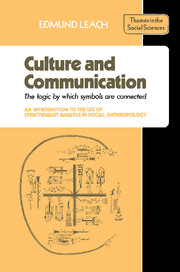 Culture and Communication
Culture and Communication The presumed average reader of this essay is an undergraduate who is just beginning to make contact with the literature of social anthropology. Some such potential readers, and perhaps some of their teachers as well, are very likely to be put off by the formalism and superficial difficulty of the argument in the opening sections, so I must justify my presentation.
Many years ago I incurred the odium of senior anthropological colleagues by daring to suggest that other people's ethnography is often very dull. I was misunderstood but I persist in my heresy.
The work of the social anthropologist consists in the analysis and interpretation of ethnographic fact, customary behaviour as directly observed. The most fundamental way in which the procedures of modern anthropologists differ from those of their predecessors a hundred years ago is that the modern treatment of ethnographic evidence is always functionalist. Today, every detail of custom is seen as part of a complex; it is recognised that details, considered in isolation, are as meaningless as isolated letters of the alphabet. So ethnography has ceased to be an inventory of custom, it has become the art of thick description; the intricate interweaving of plot and counterplot as in the work of a major novelist (Geertz (1973)).
And if we grant that, it is plain that no detail of an anthropologist's own fieldwork could ever seem dull; detail is the very essence. But the details of other people's fieldwork are perhaps another matter.
Only in very rare instances are anthropological monographs written in such a way that the reader can pick up a comprehensive feeling for the alien cultural environment in which the events described take place.
To save this book to your Kindle, first ensure no-reply@cambridge.org is added to your Approved Personal Document E-mail List under your Personal Document Settings on the Manage Your Content and Devices page of your Amazon account. Then enter the ‘name’ part of your Kindle email address below. Find out more about saving to your Kindle.
Note you can select to save to either the @free.kindle.com or @kindle.com variations. ‘@free.kindle.com’ emails are free but can only be saved to your device when it is connected to wi-fi. ‘@kindle.com’ emails can be delivered even when you are not connected to wi-fi, but note that service fees apply.
Find out more about the Kindle Personal Document Service.
To save content items to your account, please confirm that you agree to abide by our usage policies. If this is the first time you use this feature, you will be asked to authorise Cambridge Core to connect with your account. Find out more about saving content to Dropbox.
To save content items to your account, please confirm that you agree to abide by our usage policies. If this is the first time you use this feature, you will be asked to authorise Cambridge Core to connect with your account. Find out more about saving content to Google Drive.